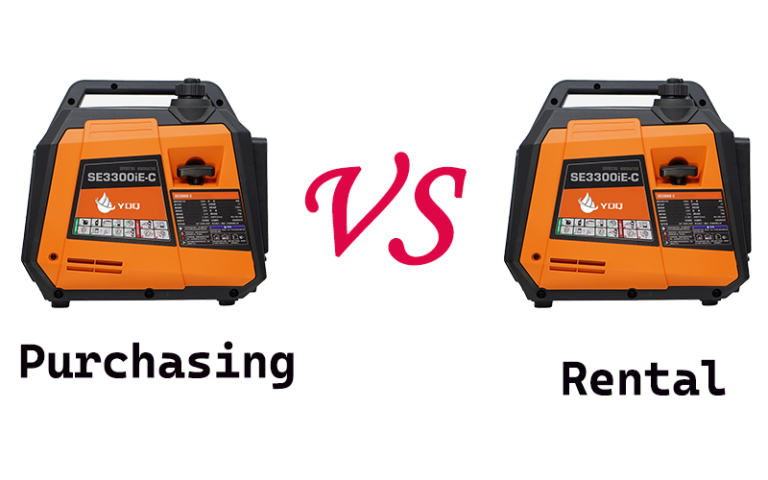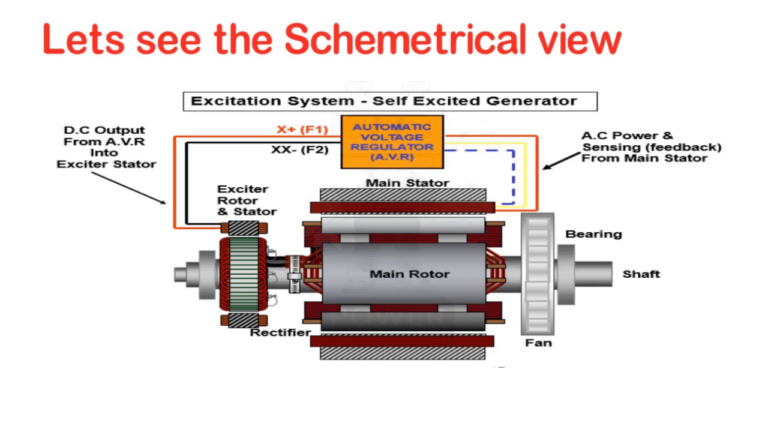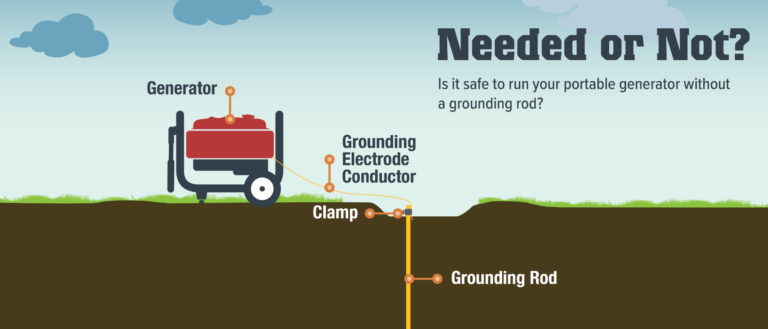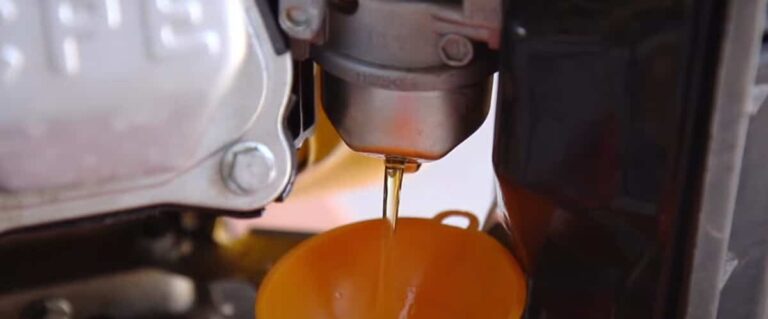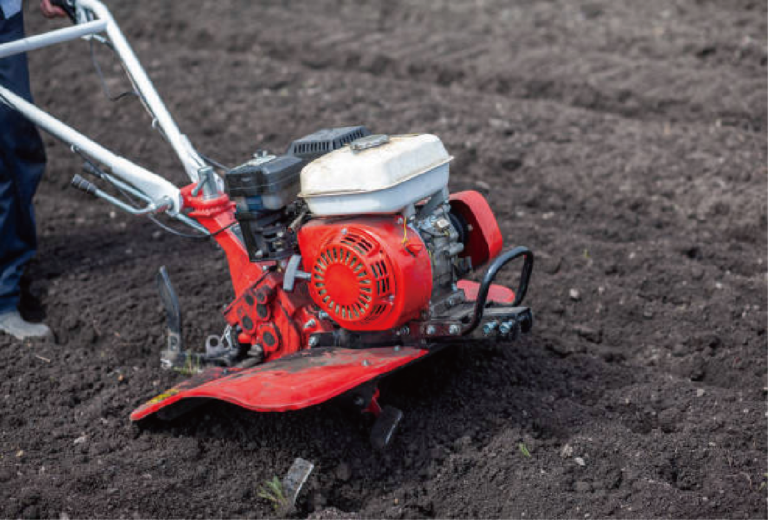Generators provide power to space and equipment during outages or in areas where standard electric service is not available. Different types of generators can meet the different needs of different scenarios. If you’ve ever wondered “what size generator do I need,” then the first step is to figure out how much total power (or wattage) you need.
Includes the amount of power required to start the device (starting wattage) and keep the device running (running wattage). In addition to generator power, you may want to consider other factors, such as physical size, noise levels, and fuel type. If you want to know how many generators I need, in other words you want to know the generator power or the total wattage. To determine the best generator for your home, you can first calculate the approximate total power requirements for each device using the following formula:
Running power (R) + starting power (R x 3) = total power required
According to the formula, plus the electrical power required for power supply, you can determine how much power is required for the generator. The more appliances you want to use, the bigger your generator will be. In this guide, we explain how to determine the correct generator size, how to calculate the total power, and the factors to consider when choosing a generator.
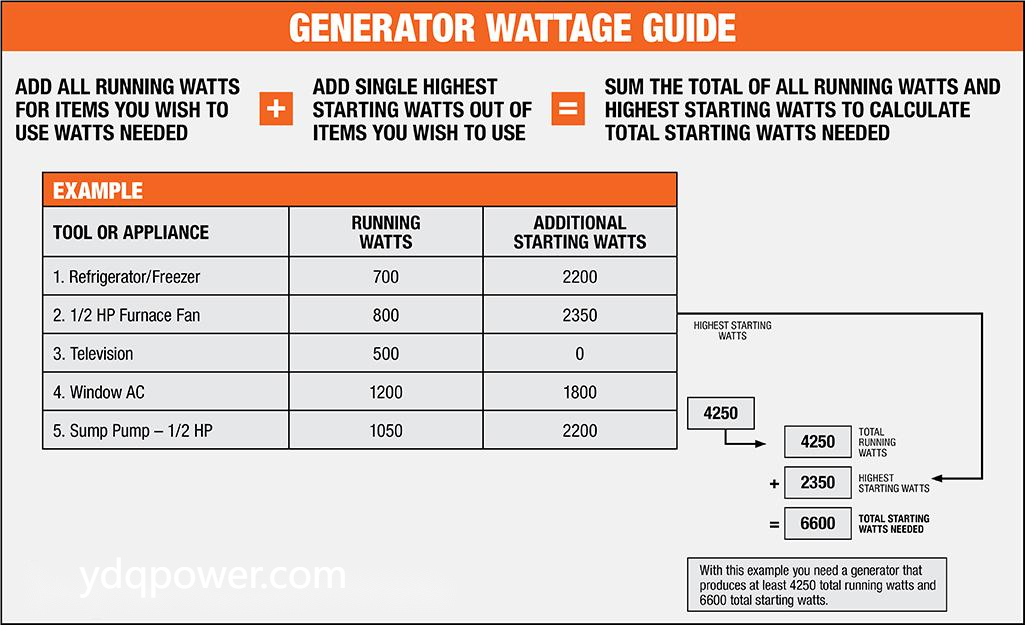
How do I calculate what size generator I need?
The generator is mainly to provide electricity in the event of a power outage. When choosing a generator, you need to consider the scenario you are using. If it is outdoor camping, tailgate party and other activities, you need to easily carry the generator to different places, you can choose the inverter generator, which has the advantages of portability, low noise and high efficiency. However, if it is an outdoor construction site, large household appliances, or a relatively empty place with large power demand, you can choose a general-purpose generator, which has the advantage of large power.
In addition to scenario considerations, you also need to calculate your power needs, and first take inventory of the equipment you want to run with the generator. Perhaps you need a generator to drive heavy machinery on a construction site. Or you need a generator set to power an entire house or building in the event of a power outage, or to power a single piece of equipment.
Since the correct size of the generator depends on the total wattage, it is important to fully understand which devices you need to power and the energy requirements of each device. When purchasing, you should consider your usage scenario and the real need for electricity in order to choose the most suitable generator.
Take Inventory of What Your Generator Will Need to Power
Before using the generator, make a list of all the important appliances that must be run during an emergency power outage, such as lighting circuits, refrigerators, and so on. Like some unimportant appliances, it cannot be run or selectively run when there is surplus power.
The power is usually labeled on the bottom, back or nameplate of a typical appliance. Appliances can have multiple power settings, so the actual amount of power consumed may vary depending on the settings used. For example, a fan running on high speed may use more power than one running on low speed.
If you can’t find the wattage on the device, check to see if the device lists the amperage. If so, you can calculate watts by multiplying amps by volts using the formula:
Watts = Volts x Amps.
If the device lists 10 amps and uses 120 volts, the wattage is 1,200 watts (10 x 120 = 1,200).
If the device does not list amps or volts, you can check the owner’s manual or the manufacturer’s website for product-specific wattage. Regardless of how you determine the wattage rating of your equipment, this is an important step in determining energy usage (and cost), ensuring that your equipment operates safely and efficiently, and calculating the correct size of your generator.
Calculate Your Total Wattage
Calculate the power required to start each device according to the instructions in the owner’s manual for the household appliance and obtain the total power required to start all devices, as well as the energy required to run them after the initial start. Then select a generator with more power than needed based on the calculated power. Select a generator with slightly more power than you need.
Choosing a generator with slightly more power will provide additional power for other equipment to use, and the generator will last longer because it is not running at full capacity. To choose the right size generator, you need to know the generator’s wattage rating and maximum wattage
Rated (Running) Watts: Running Watts is the amount of sustained energy required to keep the equipment running.
Maximum (Surge) Watts: Starting Watts is the additional watts required to start the motor to drive the equipment for the first few seconds.
The following are estimates only. Refer to the nameplate of the tool or appliance for exact wattage, or check the owner’s manual or tool manufacturer.

The wattage of generator running and starting is estimated according to different equipments, but only as a reference, the wattage of the same equipment in different countries may be slightly different, please refer to the specific equipment nameplate or user manual labeling shall prevail.
| Tool or Appliance | Running (Rated) Watts | Additional Starting (Surge) Watts |
| Air Compressor 1½ HP | 2,500 | 2,500 |
| Airless Sprayer ⅓ HP | 600 | 1,200 |
| Table/Radial Arm Saw – 10 inches | 2,000 | 2,000 |
| Belt Sander | 1,200 | 2,400 |
| Central Air Unit | 1,500 | 4,500 |
| Circular Saw | 1,500 | 1,500 |
| Color Television – 27 inches | 500 | – |
| Ceiling Fan | 800 | 1,200 |
| Deep Freezer | 500 | 500 |
| Dishwasher – Hot Dry | 1,500 | 1,500 |
| Dryer | 5,400 | 1,350 |
| Electric Drill ½ HP | 1,000 | 1,000 |
| Electric Stove – Single | 1,500 | – |
| Electric Water Heater – 40 Gallon | 4,000 | 4,000 |
| Hammer Drill | 1,000 | 3,000 |
| Heat Pump | 4,700 | 4,500 |
| Iron | 1,200 | – |
| Laser Printer | 950 | – |
| Light Bulb | 75 | – |
| Miter Saw – 10 inches | 1,800 | 1,800 |
| Microwave | 1,000 | – |
| Planer/Jointer – 6 inches | 1,800 | 1,800 |
| Personal Computer With 17” Monitor | 800 | – |
| Quartz Halogen Work Light – 300 | 300 | – |
| Reciprocating Saw | 960 | – |
| Refrigerator | 800 | 1,600 |
| Security System | 180 | – |
| Stereo Receiver | 450 | – |
| Space Heater | 1,800 | – |
| Sump Pump | 800 | 1,200 |
| Table Fan – 14 Inches | 200 | 400 |
| Washing Machine | 1,150 | 2,250 |
| Water Well Pump ⅓ HP | 1,000 | 2,000 |
| Window AC – 10,000 BTU | 1,200 | 1,800 |
Choose the Right Generator Size
Based on the estimates above, add the total operating watts of all the equipment you want to run at the same time to your maximum single start wattage. You need a generator that can handle that wattage without using 100% of the watts. Equipment runs at between 50% and 80% of the generator’s rated capacity in watts. Choosing a slightly higher wattage generator will provide additional power for use by other equipment and the generator will last longer because it is not running at full capacity.
Factors to Consider When Choosing a Generator
Wattage
The main consideration when sizing the right generator is the total wattage you need. You need a generator that is large enough to safely and efficiently meet your energy needs, but you don’t want to waste money and fuel running an overpowered generator. Generators come in different power capacities, so you need to consider whether you need a small, medium, or large industrial unit.
You can refer to the scenario you are using when choosing the right power generator, for home power backup you can choose a small generator (1-10 KW) because the power requirement is not big and at the same time it is not used frequently. For some high power equipment, such as HVAC equipment, water pumps, large household power tools, etc. you can choose a medium-sized generator (10-50KW). For offices and restaurants you can choose 50KW-100KW generators, which are usually diesel-based. Industrial premises, large offices or any premises with a large number of electrical appliances (such as computers, lights, fans and air-conditioning units) to provide power solutions, you can choose a generator of 100KW-200KW. For all-day industrial power supply, 200KW-300KW or even higher will be a better choice.
Fuel
Different types of generators use different types of fuel, including diesel, gasoline, natural gas or propane. Each type of fuel has its own advantages and disadvantages. For example, a diesel generator may cost more upfront than a gasoline generator, but it is more fuel efficient and can save money in the long run. Propane generators consume fuel three times faster than diesel generators, but propane performs well in cold weather, even during power outages when diesel and gasoline pumps may not work.
That’s why it’s best to choose what fuel you need for your generator based on how often you use it and what scenarios you use it in appropriately.
Physical Dimensions of Generators
Most types of generators fall into two main categories: portable and standby. Portable generators are easy to move around. There are small generators that can be taken camping or stored in a garage for home use. Another type of portable unit is a towable diesel generator with wheels that can be hooked directly to the back of a car. Standby generators can be stationary in one place but have the ability to provide emergency backup power for large buildings such as houses, construction sites and hospitals.
Type of Generator
Generators come in a variety of different types, sizes and fuels. The common generators available in the market can be broadly categorized as follows:
Inverter Generators
Inverter generators use special technology to produce clean, consistent energy. These models tend to be quieter, more fuel efficient, and safer for charging sensitive electronic devices such as laptops, medical equipment, or phones.
Portable generators
These smaller devices can power less energy-intensive tasks, such as charging cell phones while camping or powering power tools while working around the house. While portable generators are smaller, easier to transport, and more affordable, they can’t power an entire home or construction site due to their low power.
Standby Generators
These larger, stationary units can serve as whole-house generators or even power an entire building in an emergency. They can also be turned on automatically to ensure no downtime. They are larger and tend to be more expensive.
Towable Diesel Generators
Towable diesel generators can be hooked directly to the back of your car, so wherever you need power to go, a towable diesel generator can go with you. Whether your construction site is completely off the grid or you need to power an outdoor event, these mobile units provide a portable, fully integrated power system.
Noise Levels
Generators can make a lot of noise, so you need to consider where you plan to use them. Generally speaking, the bigger the generator the noisier it tends to be, whereas smaller (or inverter) generators tend to be less noisy. If you’re working on a construction site, a noisy generator may not pose a problem. However, if you plan to use them at outdoor festivals or in suburban areas with noise restrictions, you may need a quieter model.
Where Generators Are Used
Hospitals and Medical Centers
Standby generators provide vital backup power for hospitals and medical centers in the event of an emergency. They can help keep the lights on in operating rooms, keep vital machines such as ventilators and heart monitors working properly, and prevent refrigerated medications and food from spoiling.
Home
A home generator can keep your house from being plunged into darkness during a storm, and even allow you to do laundry, turn on the air conditioner and cook on the stove all at the same time.
Construction Site
Portable generators allow construction crews to use electricity where there are no outlets and power different machines in different locations on the site.
Outdoor Activities
Generators can provide energy for outdoor activities, powering lighting, heating equipment, audio and video equipment, cooking equipment and more.
Campgrounds
While you may enjoy spending time outdoors, you can also enjoy some modern conveniences. Portable generators can power your RV appliances, light up your campsite, and charge your devices.
How to connect a gasoline generator to the house?
Generators are an easy and inexpensive option to keep your lights and appliances running during a power outage in your home. But how should we link the generator to our house and use it normally?
There are two ways to connect the generator to the appliances in the house: one is to connect the appliance directly to the generator; the other is to connect your generator to your home grid.
The first way is to use an extension cord to connect your device directly to a portable generator outside, but this is cumbersome to use and there is no way to plug your home’s lights into the generator during a prolonged power outage, so you Will have to rely on flashlights and lamps
The second way is to connect the generator to your home’s power grid, and you can use any appliance in your home as you normally would, as long as it doesn’t exceed the generator’s voltage. The electrical outlets and lights in the home will be used as usual.

At this point, you will need a transfer switch to safely connect your generator to your home. The main purpose of a transfer switch is to switch your home’s electrical grid from the utility grid to your generator. In addition, another use of it is to simplify the power tube. The installation of the transfer switch can be done for you by an experienced electrician. Connecting the generator to the transfer switch at this point also requires a dedicated generator wire that plugs into the generator’s socket and the transfer switch’s inlet.
Before starting the generator, flip the main breaker on the transfer switch so that it draws power from the generator inlet and not from the utility grid. If you are using a manual transfer switch, also make sure that all breakers on the transfer switch are closed at this time, and make sure your generator is outside or in a well-ventilated area, then start it, at this point, you can Turn on the circuit breaker on a transfer switch to power your home.




